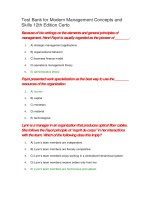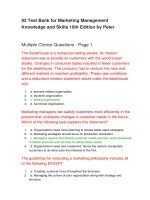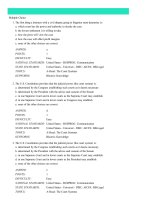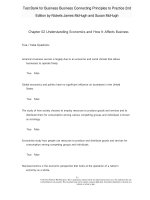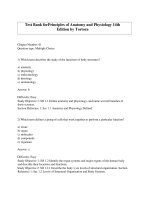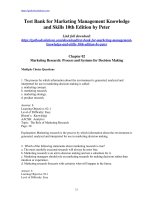Download full test bank for holes human anatomy and physiology 12th edition by shier
Bạn đang xem bản rút gọn của tài liệu. Xem và tải ngay bản đầy đủ của tài liệu tại đây (314.16 KB, 21 trang )
Test Bank for Holes Human Anatomy and Physiology 12th Edition by Shier
SAMPLE
Chapter 12: Nervous System III: Senses
Multiple Choice Questions
1. Receptors for the general senses are found
A. in a few clusters.
B. only in the integumentary system.
C. widely distributed throughout the body.
D. throughout the visceral organs.
Bloom’s Level: 1. Remember
Learning Outcome: 12.01
Shier – Chapter 12 #1
Topic: Nervous System
2. Receptors for the special senses are found
A. primarily in the head.
B. throughout the integumentary system.
C. in the fingertips.
D. in internal organs.
Bloom’s Level: 1. Remember
Learning Outcome: 12.01
Shier – Chapter 12 #2
Topic: Nervous System
3. The brain interprets input from sensory receptors as
A. reception.
B. sensation.
C. perception.
D. contraception.
Bloom’s Level: 1. Remember
Learning Outcome: 12.02
Shier – Chapter 12 #3
Topic: Nervous System
4. Sensory receptors include
A. mechanoreceptors.
B. chemoreceptors.
C. photoreceptors.
D. all of the above.
Bloom’s Level: 1. Remember
Learning Outcome: 12.02
Shier – Chapter 12 #4
Topic: Nervous System
5. The ability to ignore your socks around your ankles demonstrates
A. general adaptation.
B. receptor integration.
C. interpretive assimilation.
D. sensory adaptation.
Bloom’s Level: 3. Apply
Learning Outcome: 12.02
Shier – Chapter 12 #5
Topic: Nervous System
6. The sequence of information flow in response to biting into a slice of pizza is
A. perception, sensation, impulse send to CNS, sensory receptors activated.
B. sensory receptors activated, impulse sent to CNS, sensation, perception.
C. impulse sent to CNS, sensory receptors activated, perception, sensation.
D. impulse sent to CNS, sensory receptors activated, sensation, perception.
Bloom’s Level: 3. Apply
Learning Outcome: 12.02
Shier – Chapter 12 #6
Topic: Nervous System
7. Max returns to his dorm room late at night to find his roommate throwing up. The
smell is at first so bad that Max wants to vomit too, but after helping his roommate
clean up, the odor seems to fade. Max has experienced
A. damage to his sensory receptors.
B. sensory adaptation.
C. a response to the decreasing concentration of odorant molecules in the room.
D. a hallucination.
Bloom’s Level: 3. Apply
Learning Outcome: 12.02
Shier – Chapter 12 #7
Topic: Nervous System
8. Sensory impulses are stimulated at receptors by
A. neurotransmitters.
B. decreasing permeability of nerve cell membranes.
C. subthrehold potential.
D. local changes in their cell membrane potentials.
Bloom’s Level: 2. Understand
Learning Outcome: 12.02
Shier – Chapter 12 #8
Topic: Nervous System
9. Olfactory receptors, which provide the sense of smell, are
A. thermoreceptors.
B. mechanoreceptors.
C. chemoreceptors.
D. proprioceptors.
Bloom’s Level: 2. Understand
Learning Outcome: 12.02
Shier – Chapter 12 #9
Topic: Nervous System
10. A sensation is ______, and projection of a sensation is the ______.
A. the stimulation of a receptor cell; transmission of an impulse into the brain
B. a feeling that results from sensory stimulation; brain causing it to seem to come
from the receptors being stimulated
C. a good feeling from a stimulation; right side of the brain projecting the sensation
to the left side, or vice versa
D. a change in membrane permeability of a receptor; transmission of an impulse into
a sensory area of the brain
Hole’s Human Anatomy & Physiology 12th Edition Test Bank – David
Shier Bloom’s Level: 2. Understand
Learning Outcome: 12.02
Shier – Chapter 12 #10
Topic: Nervous System
11. Which of the following are paired correctly?
A. Baroreceptors-stimulated by blood pressure changes
B. Pain receptors-stimulated by damage to tissues
C. Thermoreceptors-stimulated by temperature changes
D. All of the above
Bloom’s Level: 1. Remember
Learning Outcome: 12.02
Shier – Chapter 12 #11
Topic: Nervous System
12. Henry has hereditary sensory and autonomic neuropathy. He lacks
A. chemoreceptors.
B. nociceptors.
C. mechanoreceptors.
D. baroreceptors.
Bloom’s Level: 3. Apply
Learning Outcome: 12.03
Shier – Chapter 12 #12
Topic: Nervous System
13. The war veteran experiences an intense burning sensation seeming to come from
where his foot had been amputated. He most likely has
A. hereditary sensory and autonomic neuropathy.
B. post traumatic stress disorder.
C. reflex sympathetic dystrophy.
D. anosmia.
Bloom’s Level: 3. Apply
Learning Outcome: 12.03
Shier – Chapter 12 #13
Topic: Nervous System
14. Another name for pain receptors is
A. tactile corpuscles.
B. lamellated corpuscles.
C. nociceptors.
D. mechanoreceptors.
Bloom’s Level: 1. Remember
Learning Outcome: 12.03
Shier – Chapter 12 #14
Topic: Nervous System
15. Pain impulses are first processed in the
A. gray matter of the posterior horn.
B. motor cortex of the cerebrum.
C. dorsal root ganglion.
D. cerebral cortex.
Bloom’s Level: 2. Understand
Learning Outcome: 12.03
Shier – Chapter 12 #15
Topic: Nervous System
16. Fibers of the spinothalamic tract transmit pain and temperature information to the
A. hypothalamus.
B. cerebellum
C. brainstem.
D. thalamus.
Bloom’s Level: 1. Remember
Learning Outcome: 12.03
Shier – Chapter 12 #16
Topic: Nervous System
17. A pole vaulter keeps track of his position in mid-air through
A. lamellated corpuscles.
B. pain receptors.
C. proprioceptors.
D. baroreceptors.
Hole’s Human Anatomy & Physiology 12th Edition Test Bank – David
Shier Bloom’s Level: 3. Apply
Learning Outcome: 12.03
Shier – Chapter 12 #17
Topic: Nervous System
18. Pain receptors differ from other somatic receptors by
A. being stimulated only when pain comes from skeletal muscle.
B. adapting very little, if at all.
C. not being able to project impulses back to their origin.
D. adapting much more than other receptors.
Bloom’s Level: 1. Remember
Learning Outcome: 12.03
Shier – Chapter 12 #18
Topic: Nervous System
19. Temperature senses use two types of
A. chemoreceptors.
B. proprioceptors.
C. tactile corpuscles.
D. free nerve endings.
Bloom’s Level: 1. Remember
Learning Outcome: 12.03
Shier – Chapter 12 #19
Topic: Nervous System
20. Pain receptors
A. respond to factors that can damage tissue.
B. adapt rapidly.
C. are among the most specialized receptors.
D. are widely distributed in the brain.
Bloom’s Level: 2. Understand
Learning Outcome: 12.02
Shier – Chapter 12 #20
Topic: Nervous System
21. The Golgi tendon organ is stimulated more when
A. muscles are metabolically active and produce oxygen.
B. muscle tension increases.
C. muscle tension decreases.
D. muscle tension stays the same.
Bloom’s Level: 2. Understand
Learning Outcome: 12.03
Shier – Chapter 12 #21
Topic: Nervous System
22. As a result of the tympanic reflex,
A. the bridge of auditory ossicles becomes less rigid.
B. vibrations are transmitted more effectively to the inner ear.
C. the malleus is pulled toward the eardrum.
D. vibrations are transmitted less effectively to the inner ear.
Bloom’s Level: 2. Understand
Learning Outcome: 12.04
Shier – Chapter 12 #22
Topic: Nervous System
23. Taste receptors are
A. found only on the tongue.
B. unable to divide.
C. modified connective tissue cells.
D. modified epithelial cells.
Bloom’s Level: 2. Understand
Learning Outcome: 12.04
Shier – Chapter 12 #23
Topic: Nervous System
24. Which of the following is not a primary taste sensation?
A. Sweet
B. Salty
C. Pungent
D. Sour
Hole’s Human Anatomy & Physiology 12th Edition Test Bank – David
Shier Bloom’s Level: 1. Remember
Learning Outcome: 12.04
Shier – Chapter 12 #24
Topic: Nervous System
25. The hearing receptors are most closely associated with the
A. ampulla.
B. spiral organ.
C. utricle.
D. saccule.
Bloom’s Level: 1. Remember
Learning Outcome: 12.04
Shier – Chapter 12 #25
Topic: Nervous System
26. The range of human hearing is about
A. 2,000-3,000 vibrations per second.
B. 2,000-200,000 vibrations per second.
C. 20-20,000 vibrations per second.
D. 2-2,000 vibrations per second.
Bloom’s Level: 1. Remember
Learning Outcome: 12.04
Shier – Chapter 12 #26
Topic: Nervous System
27. Which of the following is part of the inner tunic of the eye?
A. Retina
B. Cornea
C. Choroid coat
D. Sclera
Bloom’s Level: 1. Remember
Learning Outcome: 12.04
Shier – Chapter 12 #27
Topic: Nervous System
28. The lens of the eye thickens when the
A. suspensory ligaments pull on the lens capsule.
B. ciliary processes relax.
C. ciliary muscles relax.
D. ciliary muscles contract.
Bloom’s Level: 2. Understand
Learning Outcome: 12.04
Shier – Chapter 12 #28
Topic: Nervous System
29. Visual sensations from images focused on the side of the retina are blurred because
A. there are no rods in this region.
B. there are more cones than rods in this region.
C. there are more rods than cones in this region.
D. the optic disc is located on the side of the retina.
Bloom’s Level: 2. Understand
Learning Outcome: 12.04
Shier – Chapter 12 #29
Topic: Nervous System
30. The color receptors in the retina are most sensitive to light waves that are
A. red, green, and blue.
B. red, blue, and yellow.
C. green, yellow, and purple.
D. orange, green, and purple.
Bloom’s Level: 2. Understand
Learning Outcome: 12.04
Shier – Chapter 12 #30
Topic: Nervous System
31. Stereoscopic vision results when the
A. images in both eyes are identical.
B. images in the eyes are different.
C. rods of one eye are stimulated and the cones of the other eye are stimulated.
D. brain interprets the images in two dimensions.
Hole’s Human Anatomy & Physiology 12th Edition Test Bank – David
Shier Bloom’s Level: 2. Understand
Learning Outcome: 12.04
Shier – Chapter 12 #31
Topic: Nervous System
32. Arnold enters a darkened movie theater on a sunny summer afternoon. It takes many
minutes for his eyes to adapt to the darkness because
A. it takes some time for the retina to rebuild its rhodopsin stores from opsin and retinal.
B. the rods in the eye work only in bright light, and it takes time for the cones to work
in weak light.
C. the iris takes time to close after being subjected to bright light.
D. the optic nerve fatigues in bright light, and it takes time to recover.
Bloom’s Level: 3. Apply
Learning Outcome: 12.04
Shier – Chapter 12 #32
Topic: Nervous System
33. Rhodopsin is found in ____ cells.
A. cone
B. lens
C. rod
D. olfactory receptor
Bloom’s Level: 1. Remember
Learning Outcome: 12.04
Shier – Chapter 12 #33
Topic: Nervous System
34. Light is refracted when it passes
A. between media of the same optical density.
B. into glass at a right angle.
C. between media of different optical densities at a right angle.
D. between media of different optical densities at an oblique angle.
Bloom’s Level: 2. Understand
Learning Outcome: 12.04
Shier – Chapter 12 #34
Topic: Nervous System
35. As they extend from the retina to the brain, the nerve fibers
A. from the nasal half of each retina cross over.
B. from the temporal half of each retina cross over.
C. all cross over.
D. do not cross over.
Bloom’s Level: 2. Understand
Learning Outcome: 12.04
Shier – Chapter 12 #35
Topic: Nervous System
36. Anosmia is loss of
A. taste.
B. smell.
C. hearing.
D. vision.
Bloom’s Level: 2. Understand
Boxed Reading: Clinical Application 12.3
Shier – Chapter 12 #36
Topic: Nervous System
37. If you were a physician evaluating a young person who has conductive deafness,
which of the following would you consider in your differential diagnosis?
A. A torn tympanic membrane
B. A brain tumor
C. Damage to the auditory nerve
D. Use of the antibiotic drug streptomycin
Bloom’s Level: 3. Apply
Learning Outcome: 12.04
Shier – Chapter 12 #37
Topic: Nervous System
38. If a person’s right visual cortex is damaged, the injury will most likely affect vision
from the
A. right eye only.
B. left eye only.
C. nasal side of one eye and the temporal side of the other eye.
D. nasal side of both eyes.
Bloom’s Level: 3. Apply
Learning Outcome: 12.04
Shier – Chapter 12 #38
Topic: Nervous System
39. The taste receptor that amino acids such as glutamic acid activate is
A. sour.
B. salty.
C. bitter.
D. umami.
Bloom’s Level: 1. Remember
Learning Outcome: 12.04
Shier – Chapter 12 #39
Topic: Nervous System
40. Bitter receptors sense
A. alkaloids.
B. acids.
C. inorganic salts.
D. carbohydrates.
Hole’s Human Anatomy & Physiology 12th Edition Test Bank – David
Shier Bloom’s Level: 1. Remember
Learning Outcome: 12.04
Shier – Chapter 12 #40
Topic: Nervous System
41. Jenny slurps up a plate of beef lo mein at a Chinese restaurant. “That tastes great, but I
can’t quite describe it.” What type of taste sensation is she experiencing?
A. Paprika
B. Umami
C. Starch
D. Pepper
Bloom’s Level: 3. Apply
Learning Outcome: 12.04
Shier – Chapter 12 #41
Topic: Nervous System
42. Movement of hair cells in the semicircular canals signals
A. sound waves to the brain.
B. the direction of motion.
C. the frequency of the sound.
D. the velocity of the movement.
Bloom’s Level: 2. Understand
Learning Outcome: 12.04
Shier – Chapter 12 #42
Topic: Nervous System
43. Treatment for cataract is usually removal of the
A. cornea.
B. sclera.
C. lens.
D. vitreous humor.
Bloom’s Level: 3. Apply
Learning Outcome: 12.05
Shier – Chapter 12 #44
Topic: Nervous System
44. Glaucoma is usually caused by
A. clouding of the lens.
B. clouding of the lens capsule.
C. accumulation of vitreous humor.
D. accumulation of aqueous humor.
Bloom’s Level: 2. Understand
Learning Outcome: 12.05
Shier – Chapter 12 #45
Topic: Nervous System
Hole’s Human Anatomy & Physiology 12th Edition Test Bank – David Shier
45. Farsightedness after the age of forty-five is most likely caused by
A. loss of lens capsule elasticity.
B. shortening of the eyeball.
C. lengthening of the eyeball.
D. changes in curvature of the cornea.
Bloom’s Level: 5. Evaluate
Boxed Reading: Clinical Application 12.6
Shier – Chapter 12 #46
Topic: Nervous System
46. A person who is colorblind lacks
A. retinas.
B. one type of photopigment.
C. corneas.
D. a gene that encodes the proteins in rod cells.
Bloom’s Level: 2. Understand
Boxed Reading: Vignette
Shier – Chapter 12 #47
Topic: Nervous System
47. The painkiller sold as Ziconotide comes from a
A. bacterium.
B. fungus.
C. snail.
D. plant.
Bloom’s Level: 1. Remember
Boxed Reading: Clinical Application 12.1
Shier – Chapter 12 #48
Topic: Nervous System
48. Opiate drugs used to treat pain come from a
A. bacterium.
B. fungus.
C. snail.
D. plant.
Bloom’s Level: 1. Remember
Boxed Reading: Clinical Application 12.1
Shier – Chapter 12 #49
Topic: Nervous System
49. Lorelei thinks of the days of the week and months of the year as particular colors. She has
A. synesthesia.
B. neuropathy.
C. a deficiency of neurons in her visual cortex.
D. too few synapses in her hypothalamus.
Bloom’s Level: 3. Apply
Boxed Reading: Clinical Application 12.2
Shier – Chapter 12 #50
Topic: Nervous System
50. Smell and taste disorders may be caused by
A. a side effect of a drug.
B. allergies.
C. a head injury.
D. all of the above.
Bloom’s Level: 1. Remember
Boxed Reading: Clinical Application 12.3
Shier – Chapter 12 #51
Topic: Nervous System
51. A cochlear implant treats
A. a torn tympanic membrane.
B. otosclerosis.
C. conductive deafness.
D. sensorineural deafness.
Bloom’s Level: 2. Understand
Boxed Reading: Clinical Application 12.4
Shier – Chapter 12 #52
Topic: Nervous System
52. Otosclerosis affects the
A. tympanic membrane.
B. auditory ossicles.
C. cochlea.
D. auditory nerve.
Bloom’s Level: 1. Remember
Boxed Reading: Clinical Application 12.5
Shier – Chapter 12 #53
Topic: Nervous System
53. A curvature defect of the lens or cornea in which some parts of an image are in focus
on the retina and other parts are blurred and vision is distorted is called
A. presbyopia.
B. astigmatism.
C. hyperopia.
D. myopia.
Bloom’s Level: 1. Remember
Boxed Reading: Clinical Application 12.6
Shier – Chapter 12 #54
Topic: Nervous System
True / False Questions
54. General senses result from stimulation of receptors in the head only.
FALSE
Bloom’s Level: 2. Understand
Learning Outcome: 12.01
Shier – Chapter 12 #55
Topic: Nervous System
55. Sensory receptors are specialized cells or multicellular structures that collect
information from the environment and stimulate neurons to send impulses along sensory
fibers to the brain, where the cerebral cortex forms a perception.
TRUE
Bloom’s Level: 2. Understand
Learning Outcome: 12.01
Shier – Chapter 12 #56
Topic: Nervous System
56. Receptors that are stimulated by changes in chemical concentrations are
called thermoreceptors.
FALSE
Bloom’s Level: 1. Remember
Learning Outcome: 12.02
Shier – Chapter 12 #57
Topic: Nervous System
Hole’s Human Anatomy & Physiology 12th Edition Test Bank – David Shier
57. Stretching of tissues can cause pain sensations to arise from visceral organs.
TRUE
Bloom’s Level: 2. Understand
Learning Outcome: 12.03
Shier – Chapter 12 #58
Topic: Nervous System
58. Referred pain occurs when the brain projects the sensation back to the original source
in the body from which the pain originated.
FALSE
Bloom’s Level: 2. Understand
Learning Outcome: 12.03
Shier – Chapter 12 #59
Topic: Nervous System
59. The stapes transmit vibrations to the round window of the inner ear.
FALSE
Bloom’s Level: 1. Remember
Learning Outcome: 12.04
Shier – Chapter 12 #61
Topic: Nervous System
60. The utricle and saccule contain the sensory receptors associated with the sense of
dynamic equilibrium.
FALSE
Bloom’s Level: 1. Remember
Learning Outcome: 12.04
Shier – Chapter 12 #62
Topic: Nervous System
61. The conjunctiva is a layer of tissue that lines the inner surface of the eyelids and
covers most of the anterior surface of the eye.
TRUE
Bloom’s Level: 1. Remember
Learning Outcome: 12.04
Shier – Chapter 12 #63
Topic: Nervous System
62. The auditory ossicles are in the inner ear.
FALSE
Bloom’s Level: 1. Remember
Learning Outcome: 12.04
Shier – Chapter 12 #64
Topic: Nervous System
63. Tears contain an enzyme that reduces the risk of eye infection.
TRUE
Bloom’s Level: 2. Understand
Learning Outcome: 12.04
Shier – Chapter 12 #65
Topic: Nervous System
64. When the radial muscles of the iris contract, the diameter of the pupil decreases.
FALSE
Bloom’s Level: 2. Understand
Learning Outcome: 12.04
Shier – Chapter 12 #66
Topic: Nervous System
65. When all three sets of cones are stimulated, a person senses white light.
TRUE
Bloom’s Level: 2. Understand
Learning Outcome: 12.04
Shier – Chapter 12 #67
Topic: Nervous System
66. The taste of food is the same, whether a person has a respiratory infection or not.
FALSE
Bloom’s Level: 3. Apply
Learning Outcome: 12.04
Shier – Chapter 12 #68
Topic: Nervous System
67. The optic disc is medial to the fovea centralis and is the site from which nerve fibers
from the retina leave the eye and become part of the optic nerve.
TRUE
Bloom’s Level: 2. Understand
Learning Outcome: 12.04
Shier – Chapter 12 #69
Topic: Nervous System
68. Rods are more sensitive to light than cones, but cones are important for color vision.
TRUE
Bloom’s Level: 2. Understand
Learning Outcome: 12.04
Shier – Chapter 12 #70
Topic: Nervous System
69. Impulses from taste receptors can travel in the facial, glossopharyngeal, and
vagus nerves.
TRUE
Bloom’s Level: 2. Understand
Learning Outcome: 12.04
Shier – Chapter 12 #71
Topic: Nervous System
70. Sound vibrations are conducted from the malleus to the stapes to the incus.
FALSE
Bloom’s Level: 2. Understand
Learning Outcome: 12.04
Shier – Chapter 12 #72
Topic: Nervous System
71. Impulses from the spiral organ travel on the vestibulocochlear nerve.
TRUE
Bloom’s Level: 2. Understand
Learning Outcome: 12.04
Shier – Chapter 12 #73
Topic: Nervous System
72. Optic nerve fibers cross over in the thalamus.
FALSE
Bloom’s Level: 2. Understand
Learning Outcome: 12.04
Shier – Chapter 12 #74
Topic: Nervous System
73. Light breaks down rhodopsin.
TRUE
Bloom’s Level: 2. Understand
Learning Outcome: 12.04
Shier – Chapter 12 #75
Topic: Nervous System
74. Floaters are bowel movements that float due to a fatty diet.
FALSE
Bloom’s Level: 2. Understand
Learning Outcome: 12.05
Shier – Chapter 12 #76
Topic: Nervous System
75. Colorblindness is inherited.
TRUE
Bloom’s Level: 2. Understand
Boxed Reading: Vignette
Shier – Chapter 12 #77
Topic: Nervous System
76. A person who associates sounds with tastes has synesthesia.
TRUE
Bloom’s Level: 2. Understand
Boxed Reading: Clinical Application 12.2
Shier – Chapter 12 #78
Topic: Nervous System
77. In hyperopia, the eyeball is too short and the focal point is in front of the retina.
FALSE
Bloom’s Level: 2. Understand
Boxed Reading: Clinical Application 12.6
Shier – Chapter 12 #79
Topic: Nervous System
78. In astigmatism the cornea or the lens is elliptically rather than spherically curved.
TRUE
Bloom’s Level: 2. Understand
Boxed Reading: Clinical Application 12.6
Shier – Chapter 12 #80
Topic: Nervous System
Hole’s Human Anatomy & Physiology 12th Edition Test Bank – David
Shier Fill in the Blank Questions
79. Receptors stimulated by changes in temperature are called ____________
. thermoreceptors
Bloom’s Level: 1. Remember
Learning Outcome: 12.02
Shier – Chapter 12
Topic: Nervous System
80. The process by which the brain causes a sensation to seem to come from the
stimulated receptors is called _____________ .
projection
Bloom’s Level: 1. Remember
Learning Outcome: 12.02
Shier – Chapter 12
Topic: Nervous System
81. Pain that feeels like it is coming from a part other than the part being stimulated is called
___________ pain.
referred
Bloom’s Level: 1. Remember
Learning Outcome: 12.03
Shier – Chapter 12
Topic: Nervous System
82. The __________ is the ossicle that transmits vibrations to the inner ear through the oval
window.
stapes
Bloom’s Level: 1. Remember
Learning Outcome: 12.04
Shier – Chapter 12
Topic: Nervous System
83. The transparent, anterior portion of the eye’s outer tunic is called the _________ .
cornea
Bloom’s Level: 1. Remember
Learning Outcome: 12.04
Shier – Chapter 12
Topic: Nervous System
84. The adjustment of the thickness of the lens to make close vision possible is called
______________ .
accommodation
Bloom’s Level: 1. Remember
Learning Outcome: 12.04
Shier – Chapter 12
Topic: Nervous System
85. The ________ _________ muscle rotates the eye away from the midline.
lateral rectus
Bloom’s Level: 1. Remember
Learning Outcome: 12.04
Shier – Chapter 12
Topic: Nervous System
Hole’s Human Anatomy & Physiology 12th Edition Test Bank – David Shier

